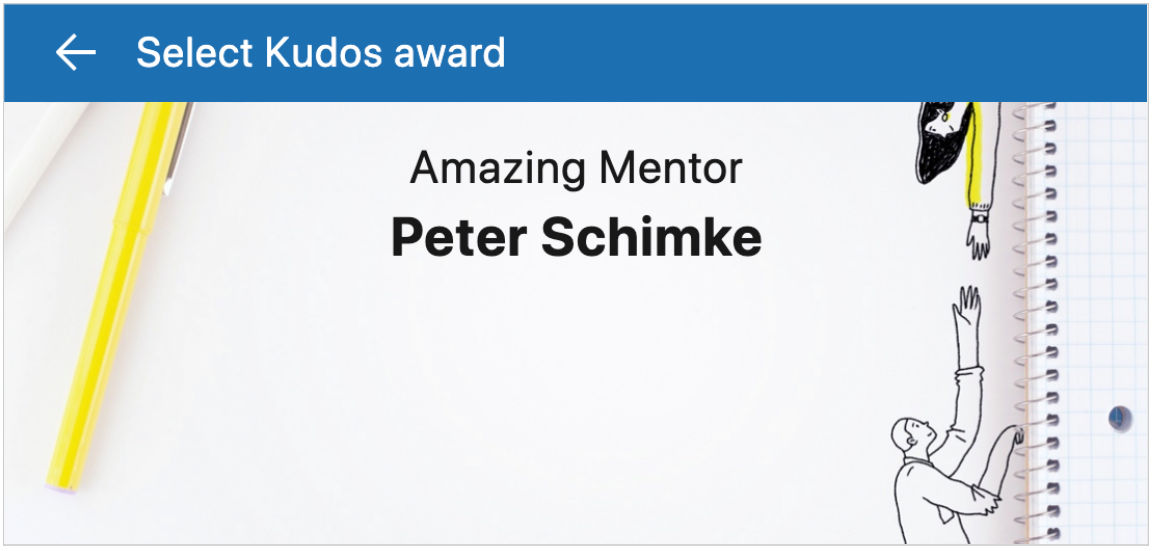Learn how influencer marketing can benefit your brand’s outreach and consumer engagement with genuine connections and tailored strategies.
From DMs to Partnerships: Building Long-Term Influencer Relationships for Brand Success
Learn how influencer marketing can benefit your brand’s outreach and consumer engagement with genuine connections and tailored strategies.
The Power of Sound: Integrating Podcasts into Your PR Blueprint
Dive into the rising influence of audio content, discover how brands leverage podcasts for strategic communication, and learn why partnering with a PR agency can maximise your impact
Unleashing Creativity and Fun on Corporate Social Media
Learn creative ways corporate brands use humour, trendjacking, memes, sarcasm, behind-the-scenes glimpses, and interactive content to connect with audiences.
What’s in a Name? How to Differentiate Between Types of Content
It happens all too often – a client says they want a blog, but when a blog is delivered, they ask why it’s so short, or why the tone is so casual. Or, they say they want an op-ed that can be pitched to a top-tier industry publication, and then don’t understand why their company’s newest product isn’t specifically mentioned or detailed in the piece.
While it’s wonderful that this client knows content will help them boost their brand and generate leads, if they don’t understand the difference between types of content, things will be frustrating for both the content team and the client. Because, unlike a rose, an op-ed by any other name is an entirely different piece of content.
When communicating with the content team you’re working with, it’s vital that you are on the same page when it comes to the types of content they are producing for you – otherwise lots of time, energy and effort will be wasted. This is because different types of content are geared for different audiences and are meant to reach different goals.
For example, if you’re hoping to increase your CEO’s profile, a social media campaign is likely not the answer – thought leadership articles are. Likewise, if you’re launching a new report and want to extend the coverage of all that data you analysed, you’ll need more than press releases – you’ll want op-eds, blog posts and maybe an infographic or two.
If all of this has your head spinning, don’t worry – we’re here to help dispel the confusion surrounding different types of content. So let’s dive in, shall we?
Social Media Copy, Explained
Oh look, a Facebook post.
Pithy, punchy and to-the-point, social media calls for short-form copy (Sometimes, extremely short-form. A tweet, for example, is a maximum of 280 characters that is attention-grabbing, informative and creative (yes, emoji are completely acceptable and hashtags are a must – they help with discovery). It should be written in your brand’s voice and have a personality that resonates with your audience.
Though there are several different types of social media platforms today, the platforms most often used for business are Facebook, Instagram, Twitter and LinkedIn. While similar messaging can be pushed out via Facebook, Instagram and Twitter, LinkedIn is a professional network that is better suited. for business goals such as brand or product awareness and communicating employer brand messaging,
Getting the tone right for each platform is an important part of crafting social media copy, so understanding how different platforms operate and which platforms your audience prefers or frequents is crucial. After all, if your target demographic spends most of their time scrolling Instagram and you’re only on Facebook, you’re missing a huge opportunity to speak directly to and engage directly with them.
Thought Leadership Posts and Articles, Explained
When it comes to thought leadership, LinkedIn is the platform you want. Your company’s executives likely all already have LinkedIn profiles in order to network and keep up with industry news. And since the platform caters to professionals, it’s the perfect place to share thoughts on the state of the industry, general business news and the thought process behind your company’s latest developments.
There are a couple different ways to publish thought leadership on LinkedIn: the first is through a post. This is short-form content – anywhere from a line or two to a paragraph – where a professional shares a quick thought about a relevant business topic or a news article they link. Though quick and efficient, these posts do provide insider insights and help to build a personal brand.
The second option is to write and share an original article on LinkedIn. This option allows more freedom and space for an executive to really delve into a topic through a longer-form piece – usually around 400–700 words – providing followers, connections and other professionals a look into their thoughts about a particular event, industry trend or piece of global news.
In addition to positioning executives as experienced, authoritative, thoughtful leaders with a unique perspective, these pieces could also lead to greater networking opportunities, speaking engagements or even business partnerships.
Blogs, Explained
Behold, a blog post.
The goal of blogs is to communicate your company’s messaging, be it reiterating your vision, launching a new product or report, providing updates to your customers, or releasing a statement in times of crisis. These pieces are where you can not just promote your company and your products, but explain them in-depth and provide behind-the-scenes information or looks at innovation.
Often, blogs and social media work hand-in-hand: you can use your social media pages to promote new blog posts by giving readers a quick taste of what’s to come in the blog and enticing them to click the link and go to your website.
Op-Eds, Explained
When it comes to pitching articles to the media, it’s generally an op-ed – short for ”opposite the editorial page” (if you want to invite us to be on your pub quiz team, we understand) – that you want to pitch. These should be thought of as thought leadership pieces because an op-ed will include a company spokesperson or executive’s name as the author and will be written in their voice, from their perspective.
But unlike writing for a company blog or for LinkedIn, an op-ed that is pitched to a publication should be long-form – usually 600–1,000 words, depending on their guidelines – and should communicate your company’s vision or leader’s thoughts without specifically selling the company or its products/services.
This is an important distinction to make, and one that is easy to misunderstand. The reason why the company’s vision or product cannot be specifically detailed or mentioned is that if it is, the publication will consider the piece as an advertorial, which is, at the end of the day, an ad. And you have to pay for ads.
Op-eds, however, do not cost your company anything if they are accepted to publication and they can not only boost brand reputation and brand awareness, but will establish your business and leaders as a trusted voice in your sector.
Infographics, Explained
A combination of copy and design, infographics help to tell a story or explain events or systems visually. These can be very effective when communicating complicated ideas that are often difficult or confusing to explain with only copy, and are great to share online on any platform.
If you’re unsure about what type of designed content it is that you want, that is completely fine – feel free to provide examples of designed content you like and the content team can help you figure out what will work best for you.
Hopefully this content primer helped shed some light on how different pieces of content operate. However, if the event you head into your next meeting with your content team and you can’t remember the difference between a blog and an op-ed, don’t tell your agency you want five blogs and five articles, hoping they’ll figure out exactly what articles mean to you. Instead, explain your business goals – your content team should be able to help you narrow down what will work best for you.
Unsure what type of content works best for your brand? The Mutant content team is here for you. Send us an email to [email protected]
How to Choose the Right Content Agency
It’s fair to say that “content” is one of the most misunderstood and overused buzzwords of all time. Don’t believe me? Then let me paint you a (slightly exaggerated but still accurate) picture that I’ve mashed together based on dozens of conversations with potential clients over the years:
Potential client: “Hi. We need some content marketing, please.”
Agency: “Alright. What are you aiming to get out of this for your business? What does successful content look like to you?”
Client: “I think we need blogs. My CEO needs a blog.”
Agency: “We can write blogs, but I’d like to know why you think you need them. What’s the goal here?”
Client: “We need more eyeballs on our website. But actually, can you create more snackable content? And make it go viral.”
Agency: “Um, I have lots of questions.”
Client: “We’ll send you all the information you need. But can you also do influencer marketing? I think that’s the best way to create awareness. Can you provide content for that? Just talk us through a typical content strategy. And give us some examples of social media content that has worked.”
Agency: *head explodes*
Here’s the thing – content is lots of things. But it can also be absolutely nothing because “content” and all it embodies has become a broad umbrella term, reduced to a catch-all phrase that ignores or pushes aside the intricacies of everything within it.
If you don’t know what your business needs from “content”, you’re not going to get very far – or many results.
So, before you approach an agency to “do content” for your business, consider the following points so that you know what to look for, what to ask, and what to be wary of:
Know what you want from an agency
I’m hitting this point again because it’s worth it. Different businesses (and people) have different definitions of what content means. To one, it will be a constant churning out of new tblogs, but to another it means planning, creating, amplifying and measuring social media posts. Then, to a third, it’s about providing a full content marketing strategy that includes everything from content creation to amplification and lead generation.
So before you approach an agency, you need to have the answers to a few key questions: Why are you even approaching an agency for content in the first place? What are the business goals you need to achieve with said content? How can an agency provide the right type of work to get you the results you need? This should be your starting point.
Oh, and pleasehave a budget. Content comes in all forms, which means the cost does, too. We want to help you – and we can – but we need to know how long that piece of string is to be able to offer the most cost-effective solution for you.
Know what to look for in a content team
While many agencies have beefed up their content capabilities, what you want is a group of people who can actually write well. And not, “oh yeah, I have a food blog in my spare time,”kind of writing. You need professional, qualified and experienced former journalists, editors and content leads who can pen a research piece on renewable energy one day, and deliver compelling social posts to launch a new perfume the next.
The members of a fully-fledged content team should work across content creation, marketing and public relations (yes, PR people should have strong writing capabilities) and be a mix of strategists, writers, editors, digital marketers, social media experts and more.
Ask about their storytelling capabilities. How do they figure out how to tell the right story? At Mutant, we hire former journalists, so we know how to probe and get all the juicy titbits of information we need to create a compelling piece. And because we are also PR experts, we know which juicy details to leave out. 😉 This integration across PR and content is absolutelykey, and will always provide stronger results overall.
Find the right fit
When you hire an individual in your company, you want to ensure the culture fit is right – the same goes for onboarding a new agency. Do a chemistry test with the entire working team for your account. Meet in person, see if you get along, talk about things other than your jobs.
Throughout this chemistry test, make sure you gain an understanding of the agency’s processes and turnaround times. How do they handle a high volume of work on short notice? How do they adapt to writing with different tones and styles (which shouldn’t be a problem for a bunch of former journalists), and how would they handle certain situations that are likely to crop up. The best results are produced in a partnership, so make sure the agency will really slot in with your team while having your best interests at heart.
Be wary of agencies that outsource everything
If it sounds too good (ahem, cheap) to be true, then it probably is. And it’s probably being outsourced somewhere with fewer checks and balances – and therefore way more difficulties and frustrations at your end.
At the end of the day, do you want something done cheaply, but that needs multiple rounds of edits to fix tone, grammar and spelling, all while dealing with people who don’t really understand your business? Or does it make more (financial) sense to increase your budget to get things right the first time around? Remember, you get what you pay for.
Ask about results
If an agency can’t share tangible results with you about the content they have produced, this should be a red flag. Results should always be the main driver behind any content – otherwise what the hell is the point?
How they will measure your business success with the work they are creating should be a key factor in choosing an agency. Not only will it help get management on board at your end, but it also means the strategy will actually work. Which, you know, is sort of important.
And there you have it – some key considerations to help you choose the right content agency.
If you have any further questions about content and what it means, feel free to drop me a line at [email protected].
3 Ways To Infuse Life Into Your Content
While creating content may seem like a simple task, consistently keeping your audience hooked is a different ball game. Blog posts and articles are often the first thing which come to mind, we talk about content. While this is true, content exists in other forms such as videos, infographics, e-books or audio. Thanks to social media, short-form video content is all the rage – all you need to do is scroll down Instagram, Facebook or YouTube, and check out the staggering number of views that some videos manage to clinch.
Want to keep your content alive, so audiences always keep coming back for more? Here are three tips:
Re-use, re-purpose, re-cycle
Great advice not only for the environment, but also the content you have generated so far. Most of which is probably timeless, so don’t let it go to waste. Posted a blog on your website two years ago? Give it a fresh lease of life, and repurpose it for a different platform. Trending topics tend to be cyclical – a specific topic you wrote about a year ago could be relevant in the present moment.
For instance, events such as the Oscars, the Super Bowl, and the prominent Fashion Weeks never fail to be a yearly occurrence. If you wrote a listicle about the major looks sported at celebrities at the Golden Globes, or penned an insightful op-ed about fashion and sustainability, why not rehash the content by giving it a fresh new twist and sharing it across your socials?
Reel them in with an irresistible headline
Putting time and effort into creating your content is great, but it’s the headline that will compel people to click on whatever you have put out. Writing a good headline involves balancing the right amount of information to let people know what to expect, yet being mysterious enough to pique their interest. Clickbait is annoying, and will only turn your readers away – be genuine with your headlines, and you will earn the clicks you deserve.
Make it personal
Customers nowadays are all about authenticity. Thanks to the Internet and social media at large, people want to see the “real” you. They want to know your story so they can be invested in it, and hopefully get to know you and talk to you (just like dating).
Give people what they want. Share stories about the team working behind the scenes to help your brand or product come to life. Hop onto Instagram or Facebook Live, or record a “Storytime” video for your YouTube audience. Social media allows for two-way communications, where your customers and fans will tell you what they think of you and your product in real-time.
Let your customers in, so they can see you for who you really are. Tell your brand story with flair, and make it human. Instead of turning it into a hackneyed old sales pitch, show people what you and your brand can do. Your content strategy should leave people hungry for more.
Want to give your content a fresh lease of life? Drop us a message at [email protected]
Personal Branding on LinkedIn – Tips For Curating and Creating Compelling Content
When it comes to personal social media, you likely have perfected your preferred combo of Facebook, Twitter, Instagram and Snapchat, curating your content and voice so that it’s very you. But what about professional social media?
When it comes to networking online, LinkedIn is where the bulk of it happens. But setting up and maintaining a professional LinkedIn profile can require a different approach than, say, your personal Instagram. So after you set up your LinkedIn profile and implement the best practices for profile optimisation, the next step is to introduce content, which adds substance to your profile. Yes, people can gauge your capabilities from your past work experience, but what’s the best way to show that you are still relevant now? To answer this question, people turn to your LinkedIn activity, checking whether you’ve shared any posts or published any articles recently. 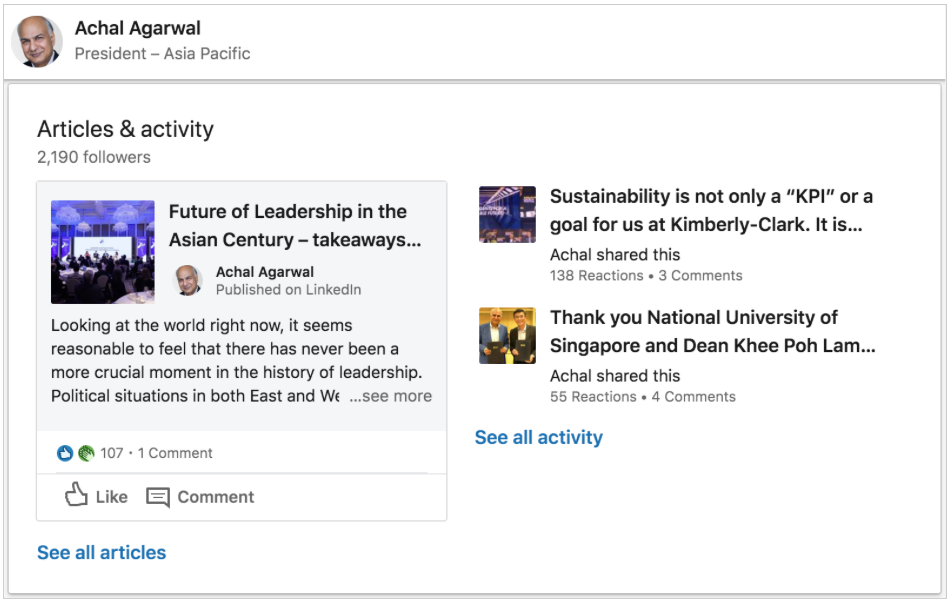
But crafting the perfect LinkedIn post requires a slightly different skill-set than a composing a pithy tweet. After all, you want to impress your LinkedIn connections with your professional acumen – maybe in addition to your wit. To learn how best to do this, read on for the how-tos of curating and creating compelling content for your LinkedIn profile.
Curate and share third-party content
In order to share great content, you first need to be up to speed on industry news. Make it part of your daily routine to read trade publications and scroll through posts from subject matter experts and the prominent hashtags on LinkedIn to keep tabs on trending topics. If you’re unsure where to begin, LinkedIn makes it easy for you to find newsletters to follow based on your profile and interests.
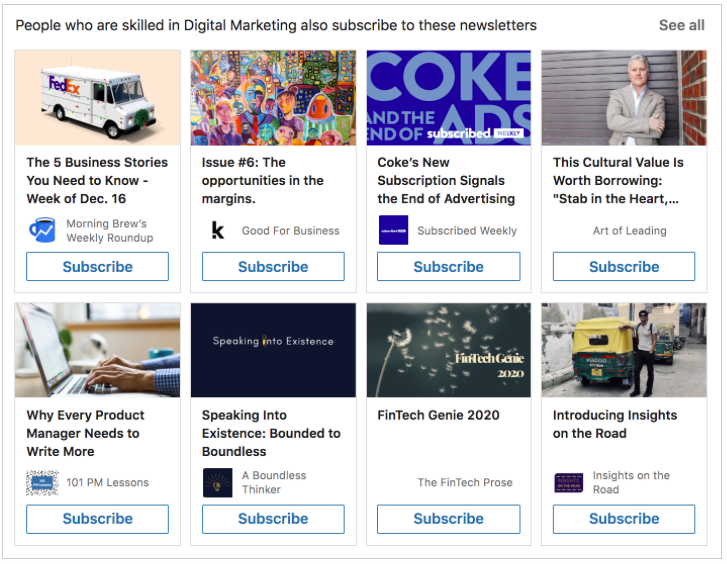
Tip: Click the “My Network” icon at the top of your LinkedIn home page and scroll down to see newsletters recommended based on your function that you can subscribe to. (Source: LinkedIn)
Navigate to the bottom of the left sidebar on your LinkedIn home page, and click “Discover more” under “Followed Hashtags” to see a list of popular hashtags related to your profile that you can follow. (Source: LinkedIn)
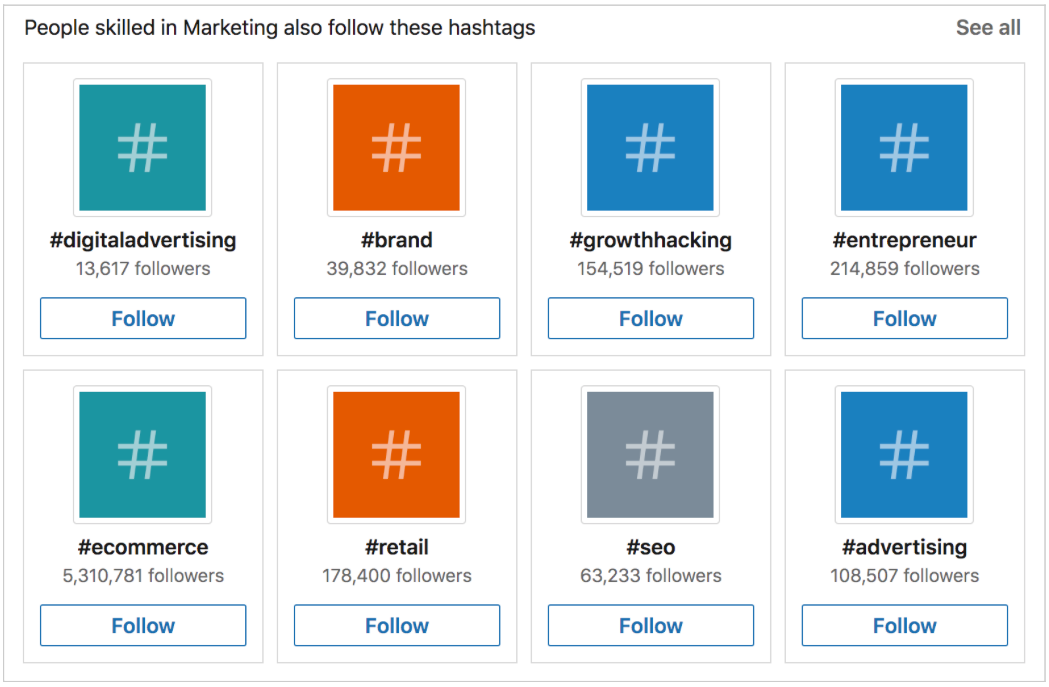
To follow more trending hashtags, you can also click the “My Network” icon at the top of your LinkedIn homepage and scroll to the bottom. (Source: LinkedIn)
Any time you come across interesting articles or opinions, be it on LinkedIn or otherwise, take some time to share it on your LinkedIn profile and add your personal thoughts or an insightful remark. That said, never post just for the sake of posting – always ensure that what you are sharing adds value for your audience. Curating and sharing content with careful intention will display your knowledge of current events and trends, improving your followers’ perceptions of your expertise.
If your employer has a LinkedIn page, a quick way to enhance your LinkedIn activity is to share pertinent posts from your company’s page. On the side, this also demonstrates commitment to your job and shows what the business you work for is all about.
Pro tip: include hashtags in your post to help other LinkedIn users discover your content and increase your reach. Similar to other social media channels, hashtags on LinkedIn work to categorise posts, and best practices suggest around three to four hashtags per LinkedIn post. But don’t get too creative: hashtags should be specific to the topic of your post, rather than about your brand alone because people are more likely to search for hashtags related to their work or interests.
Yup, I should definitely go with #WomenInBusiness instead of #OrianaAtWork.
Make use of LinkedIn’s hashtag recommendations that appear as you type in the post creator. (Source: LinkedIn
Publish owned content
Owned content refers to content you generate as opposed to content from third-party sources. It’s smart to offer a mix of content on your LinkedIn page, and complementing your sharing of third-party content with original posts and articles of your own showcases your voice and thoughts. Simple posts are ideal for brief updates and highlights, while articles are preferable for thought leadership and lengthy reflections. Before writing a full article on LinkedIn, gain a preliminary understanding of your audience using LinkedIn’s People Insights tool, which offers an overview of LinkedIn behaviours across industries.
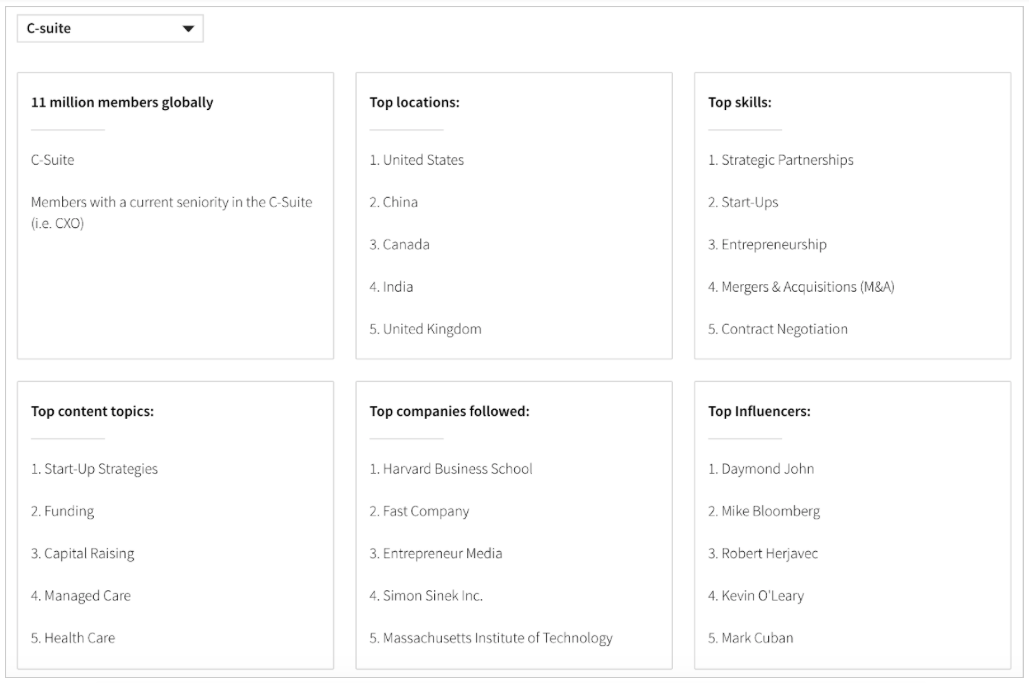
Perhaps your LinkedIn habits contributed to this snapshot. (Source: LinkedIn)
In addition to the “Top content topics” results from LinkedIn’s nifty tool, which can serve as a launchpad for article ideas, there are also broad themes across functions and industries that could appeal to your audience. Be a thought leader with substance by including subjects such as innovation, diversity and inclusion, socially responsible initiatives, as well as spotlighting deserving talent and wins in the workplace whenever relevant.
In the midst of delighting and growing your follower base through interesting and varied content, remember to maintain a unified tone of voice across all your LinkedIn posts and articles – because as any branding professional will tell you, the key to a strong brand is consistency. Whether you are friendly and effusive, or professional and succinct, let your personality speak through your writing style.
Lastly, use quality visuals that enhance your message. For LinkedIn articles, include an eye-catching cover image at the top, and intersperse text with images, videos and other rich media to segment the article and improve flow. Avoid publishing dark or low-resolution pictures, or shaky videos with poor audio. For LinkedIn posts, experiment with multiple formats. You can easily add photos and videos to your post, or use one of LinkedIn’s customisable templates to welcome a new teammate or show your appreciation for a colleague.
No one achieves success without the help of others. (Source: LinkedIn)
Give text-only posts a try, too. Contrary to popular belief, they can be effective, especially when your aim is to make a simple statement or ask a question.
When your words have weight. (Source: LinkedIn)
The content that you curate and create on LinkedIn is representative of who you are and what you stand for as a working professional. Be intentional about the topics you share about, write in a consistent tone of voice and maximise the use of LinkedIn’s publishing features to define and develop your personal brand on the platform.
Want to pen your thoughts on LinkedIn but can’t find the right words? We can do that for you! Write to us at [email protected].
Content Localisation, aka How To Be Relevant To Different Audiences
You’ve heard it before: what speaks to me might not speak to you. This is the overarching idea behind content localisation, a buzzword in content marketing, which is – just like content marketing – often misunderstood. Officially defined as “the process of making something local in character or restricting it to a particular place”, localisation is often only talked about in the context of different markets or languages. This isn’t wrong, but it does ignore a full scope of what the term means.
So what does content localisation mean, then?
Localisation isn’t just about translating text into another language, exchanging images to make the people them look like ‘local’ people or changing certain keywords to make your content more searchable in different countries. (Although that part of localisation is important, too).
Localisation means relevancy. The basic question brands need to ask themselves is this: how is my business / offering / content relevant to a particular audience?
Content localisation doesn’t just apply when moving across borders, but when appealing to different audiences in the same market. A brand’s product or offering may be of interest l to both young millennials and baby boomers, but not in the same way.
For example, the reason why Gucci has recently risen in popularity among millennials and teens is not the same reason why celebrities and more affluent older generations love wearing the fashion brand. They like it for different reasons. The brand is relevant to them in a different way. As a result, Gucci markets, or localises, its brand differently to these two audiences.
Fashion labels in particular are a great example of how a brand can be perceived differently across borders. The American brand Coach, for example, is considered a premium designer label in Southeast Asia, but has a somewhat more ordinary positioning in the U.S.
So here comes the next question: is it great content localisation if a low-quality beer from Germany is sold in Southeast Asia as a top-shelf premium import brew? I would say: yes (although slightly misleading in this case).
After all, the positioning of a brand changes with different audiences and markets depending on what else there is. (Reader: Are you saying Southeast Asia offers such bad beer that it makes other low-quality beer seem premium? Me: I would never say that.)
Let’s remember that localisation isn’t just changing imagery and translating social media copy – it’s about branding and positioning, finding a new audience, discovering a different value product. For Gucci, it was finding a way to appeal to a younger audience. For the German beer, it’s insinuating that a beverage imported from a country renowned for beer is a more informed, more high-quality choice than what is available locally.
What can content localisation look like?
- Adapting your visuals to resemble your target audience (regardless of the market)
- Using the right tone of voice and language complexity that will speak to and resonate with a particular audience
- Be aware of cultural and political sensitivities across customer segments, generations and markets
Create a flexible content strategy, instead of following a yes-or-no, black-or-white, brand strategy. Remember what is true for your brand in one market, or with a certain customer segment, may not be universally true. Rolling out a localised version of a global brand campaign is not an oxymoron.
What’s the ‘local’ channel?
The localisation of your content extends to considering which channel it will be published on. While Facebook and Instagram enjoy great popularity in Southeast Asia and across different demographics, other markets may also have other more popular channels.
For example, if you are planning to venture into South Korea, you’ll want to be on KakaoTalk, on WeChat in China, or on Line in Japan. Crossing borders doesn’t just require translations – brands also need to adapt their content to each new channel.
The same applies for different target audiences. While young millennials and Gen Zs may scroll through the TikTok and post on SnapChat, older millennials and Gen X tend to dig through Reddit to consume content.
Finding the right channel for your message is important. So do your homework and find out where your audience plays online.
Here is your content localisation checklist:
- Market Research: Find out as much as you about your new market and audiences. Is there a need for your brand? What are consumers looking for?
- Brand Research: Who are your competitors? What’s their positioning? How does your brand fit in the market?
- Cultural Considerations: What sensitive topics should you avoid? What major events and trends can you leverage?
- Content: Revise your text, images, videos, reports and more. Translate, transcreate, adapt and curate new content.
- Audiences: Find new audiences that you may have not considered previously. Test and learn about who you are talking to.
- Measure: That’s the only way to find out what actually works. Make sure you measure your activities and campaign.
Get lost in translation? Don’t worry, it even happens to Bill Murray – and he’s great. If you want to talk about how to upgrade your content to cross borders or find new audiences (or chat about Bill Murray over some Suntory), send us a message to [email protected].
4 PR Trends to Look Out For in 2019
It’s that time of year where companies take stock of their performance in the first quarter of 2019 and make plans on how best to move into their new fiscal year. If your numbers aren’t what you hoped, or it’s clear you need a new strategy, now is the time to pivot. To help get you on your way, here are four PR trends you should watch out for in 2019:
1) Content marketing will be better aligned with PR
PR teams are often the best advisors to lead the content marketing narrative, as they own the brand narrative and are great at storytelling. As marketing teams see an increase in engagement and quality leads driven by strong content strategies, PR folks will move from just amplifying content to being more involved with assisting in the initial stages of crafting it.
2) PR pros will prove their worth with savvy measurements
Moving beyond vanity metrics, PR teams will be under pressure to prove how they have impacted the bottom line. PR firms that don’t do this well will get left behind. By showcasing how earned media ties into building awareness, engagement, trust and even leads, 2019 will be a year of absolute accountability. Using tools to measure share of voice, sentiments and lead generation is the way forward.
3) PR tech stack will drive more efficiencies
Gone are the days where an entire morning is spent media monitoring (thank goodness!). With news alerts pushed 24/7, there’s simply no reason to do this any longer.
From data-driven newsjacking to spotting a crisis before it escalates through real-time social listening, the right tech tools can help a team focus on what’s important by automating tasks – such as reporting and upkeeping an ever-changing media database. PR teams should invest in the right tech stack in 2019 to become more efficient and agile.
4) More journalists will join the “dark side”
The “dark side” is an old trope, but it ain’t so “dark” anymore. As the need for great content-driven by storytelling increases, more writers – including experienced journalists and editors – will find great opportunities in communications. At Mutant, we have built a team of senior editors and writers who are essential to creating smart content that’s amplified through PR.
At the end of the day, storytelling is at the core of what we do as PR professionals, and that won’t change. But how brand stories are told and the ways in which PR and marketing teams operate are changing – and those companies that need to breathe new life into their strategies should consider jumping in on these four trends in order to have a great 2019.
If you want your brand to keep up in 2019 and beyond, give us a shout at [email protected]
Is product placement right for your brand?
Remember that epic selfie Ellen DeGeneres took at the 2015 Academy Awards ceremony with the Samsung Galaxy Note 3? That tweet not only broke the record for retweets previously set by President Obama, but also caused Twitter’s servers to crash.
At this year’s Golden Globes, Fiji Water attempted a similar stunt by hiring model Kelleth Cuthbert, who spent most her time photobombing stars on the red carpet while holding a tray of Fiji Water bottles. The stunt worked: the hashtag #FijiWaterGirl trended on Twitter, and earned 98.9 million impressions on the platform.
As far as product placements go, Samsung is still the one to beat – but there’s no one-size-fits-all approach for successful product placement. Brands are often torn between seamlessly integrating products into the broader narrative, or making it apparent enough to trigger a viral moment on social media.
So, how do you decide what’s right for your brand?
Start with a goal
The goal of any product placement is to reach your target audience, but having precise goals is key to ensuring success. Do you want to drive brand awareness? Is it higher recall you’re after, or are you aiming for greater brand loyalty? Answering these questions will not only inform your strategy and approach, but also help identify the metrics you use to measure success.
Whatever your objectives are, public relations can play a crucial role in reaching your desired audience, and then sparking and shaping conversations with them. There are many ways a strong PR strategy can do this – and tied with a content marketing approach it can go beyond awareness and actually drive leads for your business that you can track and measure.
Make it believable
Pulling off a product placement tie-in is only successful if it is believable. When deciding on a partnership, brands need to identify whether it’s a good fit and in line with its own tonality and values.
Don’t force your brand into a piece of content where it doesn’t feel right – because you will get called out. Reebok’s association with Jerry Maguire is a great example of product placement gone wrong. Reebok paid production company Tristar $1.5 million to feature its products, but the company somehow ended up being portrayed as a villain because of its refusal to sponsor Cuba Gooding Jr’s character. After some legal back and forth, the two companies reached a settlement, which included an ad for Reebok in the film’s credits.
Consider different content types
For most marketers, TV shows and movies are obvious product placement choices. But increasingly, we’re seeing brands experimenting with other formats, only to reap rich rewards. Coca Cola and Subway have both used video games to promote their brands, while musicians like Lady Gaga and Kanye West have seamlessly included brands in their music videos. For instance, brands such as Miracle Whip, Polaroid and Virgin Active made conspicuous appearances in her “Telephone” video, while West’s video for “Wolves” doubled as a promotional ad for fashion house Balmain.
As a marketing tactic, product placements can work incredibly well or backfire spectacularly – so be savvy and cover all your bases when considering a new association.
Want to put some cool products in your ad? We’ll tell you how to go about it when you email us at [email protected]
How to grow your business with content marketing in 2019
The year is in full swing and marketing strategies are being rolled out… but maybe you kind of haven’t started yours yet? Don’t worry, it’s not too late to begin – especially since content marketing isn’t solely about driving leads, but the stories you want to tell.
Based on our content marketing experience with brands across Singapore and Southeast Asia, we have put together a few tips and techniques you can use to beef up your efforts this year, regardless of whether you have done your marketing homework or not.
#1 Quality over quantity
Although a regular content output remains important, the quality of each piece is more important than ever before. With thousands of posts, articles and newsletters being published and pushed out every single day, the sheer volume of available content is overwhelming. Simply rehashing your competitors’ communications won’t be convincing or engaging, to say the least.
If you are going to create content in 2019, make sure it matters to your audience and feels fresh. Whether it’s your own opinion posted to LinkedIn, your next company blog or a product-related post on Facebook, give it substance, a point of view, and ask yourself if it adds any value. Also, don’t simply produce content for the sake of it – instead publish content when you have something to say.
Want to know more about how to take a stance as a brand? Read this.
#2 Email marketing doesn’t rely on algorithms
If you are worried about social media advertising algorithms messing about with your budget, then it’s time to revitalise your email marketing strategy. Email is one of the only channels that doesn’t rely on ever-changing algorithms.
Whether you already have a solid database or are just starting out, an email marketing strategy is a worthy investment. With great visuals, quality content, and an opinionated subject line, you can grab the attention of the people that matter.
Tip: Don’t overload your newsletters with too much content. Have a topic that ties back to your business for each newsletter.
#3 Influencers? Yes, but…
It’s the age if the influencer… including the ‘fake’, wannabe inauthentic ‘influencers’ that pop of everywhere claiming to have a phenomenal reach. There are just as many ‘fake’ influencers promoting their services and reach to any brand that is keen enough listen as there are real ones, and so it comes as no surprise that Instagrammers look to buy followers or use other shady tactics. Just last year, Singapore-based Daryl Aiden Yow was exposed for passing off stock images as his own, offering his photography services at the same time.
To identify influencers who actually add value to your business, take a deep look into their feeds. Look critically at their engagement and comments. If it seems legit, it’s time to meet them – if not in person, then at least over a quick call. Their personality and attitude will often provide better insight into whether they are in it for a quick buck or if they are passionate content creators worthy of investment.
#4 Merge quality with measurement
We can’t say it often enough – create, measure, analyse and optimise. While this may sound straightforward, these simple steps divide content teams everywhere.
There are two camps in content marketing: On one side are the editorial purists, who polish each sentence until it could win a literary prize. On the other side are the SEO-minded Google Analytics marketers, who tend to produce conglomerations of keyword that will make great use of checklists and algorithms.
Who’s the better content marketer? Well, they both are, if they work together.
The truth is that the most common concern regarding content marketing, especially among SMEs and startups, is related to their return on investment (ROI). Be it brand awareness, website clicks, conversions or leads, setting KPIs and measuring your content rigorously is important. But it’s equally important to craft well-written and informative pieces that people actually want to read.
#5 Don’t forget about employer branding
Content marketing is not only a way for brands to create awareness for their products and services, but also to attract and recruit highly-skilled talent.
While a lot of brands successfully market their offerings and attract customers, they are often not so great at telling their story as an employer and engaging the right people to work for them. Though client work always comes first, remember that without the right people working for your company, you won’t be able to offer the highest quality work or grow your business.
Ensure you communicate across different channels, highlighting aspects of your business that matters to the audiences on each channel. While your company blog is a great way to showcase your expertise and express thoughts more freely on a variety of topics, Facebook and Instagram should highlight the fun side of your company in a way that’s as visual as possible. Both LinkedIn and Glassdoor are not only platforms to post jobs but are great for communicating company news to a professional audience. However, don’t forget to leverage marketing and HR titles (or other trade titles) to express your thoughts and opinions on the wider industry.
Need help with some or all of the above? Just say ‘hi’ at [email protected] and we’ll talk.


